Octopuses are among the ocean’s most intelligent invertebrates—cephalopod mollusks with globular heads, well-developed eyes, and eight sucker-lined arms. Their intelligence rivals that of many vertebrates, and they have evolved a suite of fascinating strategies for defense, hunting, and even using tools. One of their most remarkable adaptations is the ability to produce toxins that paralyze and subdue prey, and in some species, pose real risks to humans. In this guide, we explore the world’s 10 most venomous octopus species—their characteristics, distribution, and how their venom works.
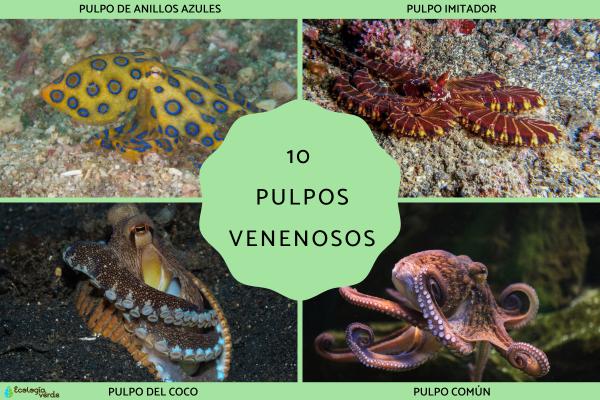
Blue-ringed Octopus (Hapalochlaena spp.)
Mimic Octopus (Thaumoctopus mimicus)
Giant Pacific Octopus (Enteroctopus dofleini)
Coconut Octopus (Amphioctopus marginatus)
Common Octopus (Octopus vulgaris)
Blanket Octopus (Tremoctopus violaceus)
California Two-spot Octopus (Octopus bimaculoides)
Dumbo Octopus (Grimpoteuthis spp.)
Seven-arm Octopus (Haliphron atlanticus)
Pacific Pygmy Octopus (Paroctopus digueti)
Measuring just up to 20 cm, the blue-ringed octopus is considered the most toxic animal in the sea. Its yellow or brown body is covered in bright blue rings—a striking warning to potential predators. Inside its salivary glands lies a neurotoxin (tetrodotoxin) so potent it can kill a human within minutes; there is currently no known antidote.
Caution: Although not aggressive, most bites to humans occur due to accidental contact or handling.

Renowned for its incredible mimicry, this octopus can impersonate a range of sea creatures—lionfish, sea snakes, jellyfish, and more—to evade predators or lure prey. It’s found in Southeast Asia’s shallow, sandy reefs. The mimic octopus is a diurnal hunter, feeding on crustaceans and small fish, using venom to subdue its prey before eating.

The largest octopus species on earth, reaching up to 9 meters, and the longest-lived (up to 4 years). It has a reddish coloration and is a master of camouflage, able to rapidly change color and texture. Its large size means it preys on clams, lobsters, fish, and sometimes even sharks and seabirds, using venomous saliva to immobilize them.
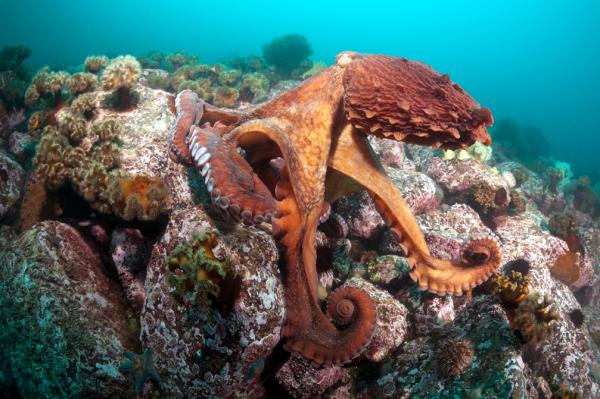
One of the most intelligent octopuses, famous for its tool use—it carries coconut shells, clam shells, bottles, or other debris as mobile shelters and hunting blinds. To eat, it uses sharp beaks and suckers to grip prey, then injects venom and digestive enzymes to soften the tissues before consuming the flesh.

This species has a short life span (one or two years) and is widely distributed in oceans worldwide, hiding in rock crevices down to 100 meters. It mainly preys on crustaceans, using arms to capture and bring prey to the mouth, where it injects a venom called cephalotoxin that paralyzes the victim’s nervous system in minutes.

A pelagic octopus with long, broad webbing (like a blanket) covering its first four arms. It uses this “blanket” both for movement and to startle predators, sometimes even detaching it as a decoy. Females can reach up to 2 meters, while males are tiny by comparison. This species also uses venom to subdue prey.
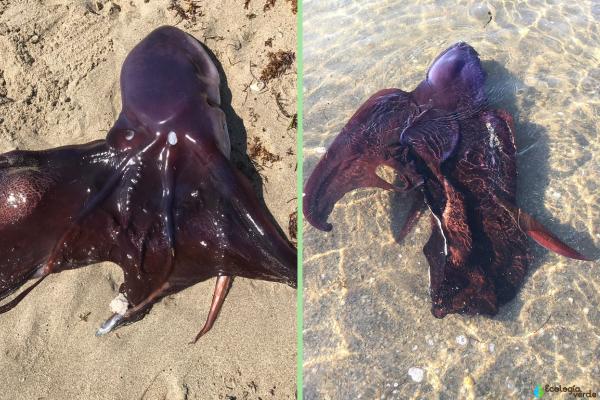
Distinguished by two bright blue spots on either side of its head, resembling false eyes. It ranges from California down the Baja Peninsula, inhabiting reefs, kelp forests, marshes, and sandy bottoms. It feeds on mollusks and crustaceans, using its venom to incapacitate those it can’t easily open.

Named for the ear-like fins on its head, reminiscent of Disney’s Dumbo. These deep-sea cirrate octopuses use a web between their arms to swim and capture prey by “pulsing” through the water. They feed on amphipods, copepods, and other crustaceans, using venom to digest prey in the darkness of the deep sea (up to 7,000 meters deep).
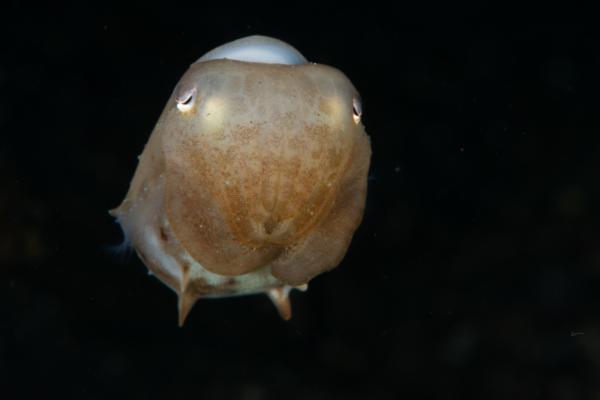
A massive species that can reach 4 meters. Named because the male’s specialized reproductive arm (hectocotylus) is usually hidden in a sac near the eye, making it look like it has only seven arms. It’s pelagic, widely distributed, and feeds on jellyfish, shrimp, and amphipods. It is preyed upon by blue sharks and sperm whales.
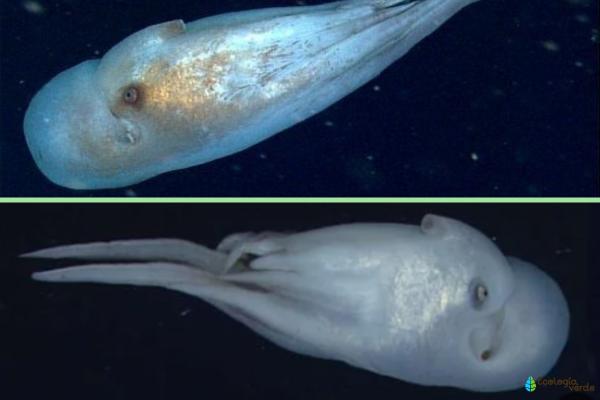
Little is known about this small, short-armed species, found in Mexico’s shallow, muddy waters. It prefers empty shells for egg laying. It eats shrimp, small mollusks, crabs, and fish, using venomous saliva to catch and digest its prey.
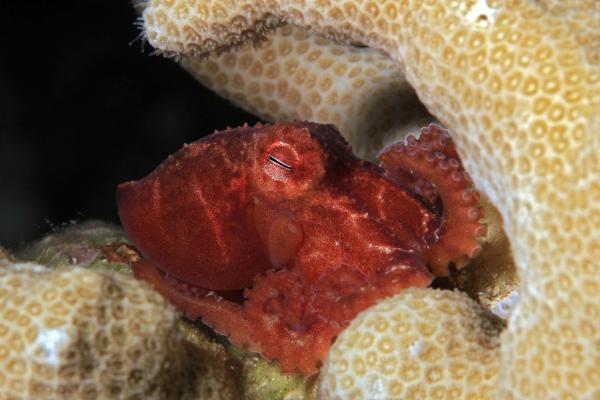
Many octopus species have evolved potent venoms, not just as tools for hunting but as crucial defenses against predators. Understanding their diversity, distribution, and dangers is essential for marine safety and scientific knowledge. Want to learn more about octopuses, marine life, or animal toxins? Follow our site for more in-depth articles!
Bibliography
Coker DJ. 2012. Documentation of the mimic octopus Thaumoctopus mimicus in the Great Barrier Reef, Australia. Available from: https://sci-hub.st/https://doi.org/10.1017/S175526721200125X
Field-Cortazares J, Calderón-Campos R. 2010. Envenomation by the Blue-ringed Octopus. Available from: https://www.medigraphic.com/pdfs/bolclinhosinfson/bis-2010/bis102j.pdf
García Flores M. 2017. Early ontogeny and fecundity of the Pacific pygmy octopus Paroctopus digueti (Perrier and Rochebrune, 1984). Available at: file:///C:/Users/user/Downloads/garciaflo1.pdf
Guerra A. 1978. On the diet and feeding behavior of Octopus vulgaris. Available at: https://digital.csic.es/bitstream/10261/87157/1/Guerra_1978.pdf
Hoving HJT, Haddock SHD. 2017. The giant deep-sea octopus Haliphron atlanticus forages on gelatinous fauna. Available at: https://www.nature.com/articles/srep44952
Ibarra García LE. 2012. Age and growth analysis of Octopus hubbsorum (Berry, 1953) and Octopus bimaculoides (Pickford and McConnaughey, 1949) using stylet growth ring readings. Available at: http://dspace.cibnor.mx:8080/bitstream/handle/123456789/294/ibarra_l.pdf?sequence=1&isAllowed=y
Murcia Requena FJ. Veiled octopus, a strange cephalopod. Available at: https://digitum.um.es/digitum/bitstream/10201/29167/1/El%20Pulpo%20de%2
animal tags: Octopuses
We created this article in conjunction with AI technology, then made sure it was fact-checked and edited by a Animals Top editor.